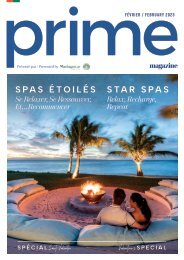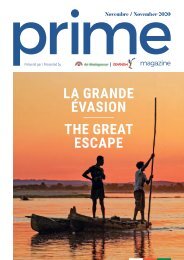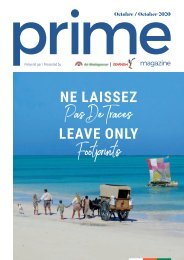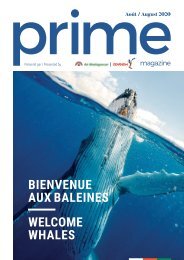Prime Magazine March 2020
You also want an ePaper? Increase the reach of your titles
YUMPU automatically turns print PDFs into web optimized ePapers that Google loves.
DESTINATIONS<br />
Parc National Zombitse Vohibasia<br />
Nature SAUVAGE<br />
Le parc national de Zombitse Vohibasia ouvre ses portes majestueuses, accueillant les visiteurs<br />
dans cette riche forêt à la nature sauvage au cœur de la savane du mythique Sud profond.<br />
WILD Nature<br />
The Zombitse Vohibasia National Park opens its majestic gates, welcoming visitors to this rich<br />
forest with its wealth of wild nature in the heart of the savannah of the mythical deep south.<br />
C<br />
ette aire protégée, constituée par un complexe<br />
forestier, est connue pour son exceptionnel<br />
avifaune: 47% des oiseaux qui peuplent le<br />
paysage parfait de ce site se trouvent uniquement<br />
à Madagascar et 24% d’entre eux dans la région.<br />
On peut citer le Phyllastrephus apperti ou le Bulbul d’Appert,<br />
une espèce endémique qui chante avec des notes très hautes<br />
et répétées. Leurs doux chants,<br />
Côté flore,<br />
Zombitse<br />
Vohibasia n’a<br />
rien à envier<br />
aux autres aires<br />
protégées de l’île<br />
considérés comme synonyme des<br />
beaux jours, bercent les visiteurs en<br />
quête de lien avec la nature, version<br />
grand N.<br />
Bien que ce parc national soit un<br />
véritable eldorado pour les amateurs<br />
et les ornithologues, Zombitse<br />
Vohibasia est aussi l’habitat<br />
naturel des fameux lémuriens.<br />
Vous y découvrirez notamment Le<br />
Propithèque de Verreaux (une des<br />
8 espèces ayant trouvées refuge<br />
au sein de ce petit coin de paradis).<br />
Avec son pelage entièrement<br />
blanc, hormis une couronne brun<br />
foncé sur le haut du crâne, il vous<br />
sera difficile de le rater. Côté flore,<br />
Zombitse Vohibasia n’a rien à envier<br />
aux autres aires protégées de l’île.<br />
L’arbre étrangleur, appelé Mandresy<br />
dans la partie sud de Madagascar,<br />
est un des plus fascinants : il<br />
germe et grandit sur un autre arbre qui lui sert de support. Ce<br />
dernier termine littéralement « étranglé » par les racines qui<br />
grossissent, se soudent entre elles et forment, pour finir, une<br />
sorte de cage qui aura raison de son existence. Les espèces<br />
de baobabs comme le baobab de Grandidier et le baobab nain<br />
viennent compléter la diversité de cette faune extraordinaire.<br />
In terms of<br />
flora, Zombitse<br />
Vohibasia is up<br />
there with the<br />
other protected<br />
areas of the island<br />
This protected area, made up of a forest<br />
complex, is known for its exceptional<br />
birdlife. Forty-seven percent of the birds<br />
that populate the perfect landscape of<br />
this site are found only in Madagascar<br />
and 24 percent of them only in the region. There's<br />
the Phyllastrephus apperti or the Bulbul d'Appert, an<br />
endemic species that sings with<br />
very high and repeated notes.<br />
Their sweet songs, considered<br />
synonymous with beautiful days,<br />
uplift visitors in search of a link<br />
with nature.<br />
Although this national park<br />
is a real El Dorado for amateur<br />
bird watchers and ornithologists,<br />
Zombitse Vohibasia is also the<br />
natural habitat of the famous<br />
lemurs including the Verreaux's<br />
Sifaka (one of the eight species that<br />
has found refuge in this little corner<br />
of paradise). With its entirely white<br />
coat, except for a dark brown crown<br />
on the top of the skull, it's difficult to<br />
miss it. In terms of flora, Zombitse<br />
Vohibasia is up there with the other<br />
protected areas of the island. The<br />
strangler tree, called Mandresy in<br />
the southern part of Madagascar,<br />
is one of the most fascinating; it<br />
germinates and grows on another tree that serves<br />
as a support. The latter ends up literally strangled<br />
by these roots that grow, weld together and form<br />
a kind of cage, the way it survives. Baobab species<br />
such as the Grandidier baobab and the dwarf baobab<br />
complete the diversity of this extraordinary fauna.<br />
<strong>Magazine</strong> online<br />
www.primemedia.international<br />
| 77 |

















